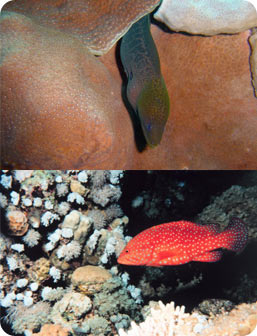On their own, groupers and moray eels are two fearsome coral reef predators. Groupers feed by gulping down prey in the open water, while morays can pursue fish into hiding places in a reef. But when the two team up to hunt, they’re a lethal team, leaving prey with nowhere to swim or hide.
 A giant moray eel (top) and a grouper in the Red Sea. Credit: National Oceanic & Atmospheric Administration
A giant moray eel (top) and a grouper in the Red Sea. Credit: National Oceanic & Atmospheric AdministrationIn a 2006 study, scientists observed groupers and giant moray eels in the Red Sea cooperating to hunt reef fish. A grouper would swim up close to a resting moray eel and “signal” to it with a head-shaking motion — inviting the eel to join the hunt. More than half the time, the moray would swim off with the grouper.
Researchers saw that the grouper would indicate the presence of prey by doing a “headstand” over the crevice in the reef where the prey was hiding. The moray would then pursue the prey into the crevice. Sometimes, the moray would swallow the prey whole; other times, the prey would flee to open water - where the grouper would be waiting to snatch it.
This study found that groupers were five times more successful at catching prey when hunting with a moray than when hunting alone. Also, because morays typically hunt at night, hunting with a grouper helps them expand their hunting opportunities into the daytime.
Scientists are unsure whether cooperative hunting is an instinctive behavior for groupers and eels, or whether it is something they learn. Whatever the case, this unusual cooperation helps both kinds of fish boost their chances of catching a meal.


